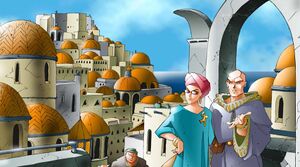Thebes
Thebes was one of the first cities established during the first full wave of colonization. The city is well known for its cyclopean stoneworks which date back to the 10th century. As an archaeological center, Thebes rivals Olduvai. While richer in potential dig sites, Thebes’ greater level of urbanization makes accessing these finds difficult.
Thebes' early colonial sites are very interesting for Terranovan archeologists. Indeed, the site was set up as a scientific settlement in the early days of the colonial effort, but much of the community seems to have gone native around the scientific settlement. There are plentiful ruins of low-tech fishing villages coexisting with scientific establishments. There are also remains of exploration period stations, dating from before colonization of the Humanist Alliance region. Some point to a continuity in structures to theorize that early settlement did not die out before the establishment of Thebes proper, but rather had dispersed into a series of fishing communities around the lake that merged with the scientific community in the fifth and sixth Terranovan centuries.
The city-state of Thebes serves as a kind of engineering think tank for the Humanist Alliance. It is here that the Alliance built their world-class engineering school, the Thebes Design Institute. The city is home to countless small engineering firms and corporate research and development facilities. Its population has a high ratio of preceptor engineers and business people. The concentration of high-technology industries in Thebes makes the city a constant target of speculation. There are rumors of an entire series of new vehicles and Gears being designed and tested here.
One disreputable tabloid reported that powerful new energy weapons had been tested in Thebes over the past five cycles. The Preceptor of the City laughed off the allegations, stating that the Alliance had better things to do than find new ways to destroy things. The engineers and designers of the city are in a state of almost constant conflict with the its archeologists. Each scientific discipline demands more space and resources from the Humanist and Theban governments. The conflict is made worse by the fact that engineers often want to build facilities over potential archeological sites, while archeologists are always uncovering ruins under valuable industrial compounds. City preceptor Olbian must navigate between these competing interest groups.

